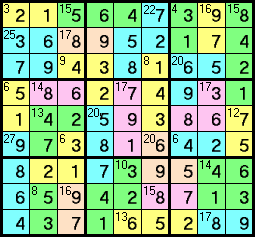Killer Sudoku
Killer Sudoku (also known as Sum Sudoku or Samunamupure ) is a number puzzle that combines elements from Sudoku and Ken Ken . Killer Sudoku are quickly confused with area totals. However, Killer Sudoku must not contain a number twice compared to area sums in a sum. Despite the name, killer sudokus can be easier to solve than classic sudokus.
Structure and rules
A killer Sudoku consists of a rectangle divided into several rectangular blocks of the same size; the blocks in turn are divided into individual fields. In addition, the playing field is divided into several groups of any shape, regardless of the blocks. In each group there is a small number.
As a rule, Killer Sudokus, like Sudokus, consist of 3 × 3 blocks, each containing 3 × 3 fields. Different methods are used to identify the blocks and groups, mostly a combination of colored backgrounds and dividing lines of different thicknesses.
The fields must now be filled with digits so that the following conditions are met:
- only the numbers 1, 2, 3, 4, 5, 6, 7, 8 and 9 are permitted
- each of these digits must appear exactly once per row, column and block
- the sum of the digits in a group must be exactly the same as the number given for that group
- a number may appear only once in a group
The last rule, which is undisputed in Japan, was not mentioned in the early publications in The Times , confusing readers.
Furthermore, killer sudokus of other sizes are also conceivable, e.g. B. with 4 × 4 blocks each with 4 × 4 fields, in which the numbers from 1 to 16 must be inserted according to the same rules as above.
Usually the given numbers and ranges clearly define the solution.
history
Killer Sudokus appeared in Japan as a Sudoku variant in the mid-1990s, where they were known under the name Samunamupure ( sham Anglicism , derived from English sum number place ). They were introduced in the English-speaking world in 2005 by The Times magazine.
Solution methods
To solve a killer Sudoku, you try to enter more and more numbers in the corresponding fields, which then add up to ever larger areas.
Simple killer sudokus contain groups of just one square, which are of course unique and contain the corresponding number. Furthermore, the specified sum can often be used to narrow down the numbers that are still possible in this group. For example, in the most common form of a killer Sudoku with nine digits per block, a group with two fields and a total of 3 can only contain the numbers 1 and 2 and one with the total 7 only contains either 1 and 6 or 2 and 5 or 3 and 4 contain. Through logical considerations, the appropriate combination options can be specified for all further sums and also for larger areas.
Sometimes numbers can be calculated instead of being determined by combinations. The sum of all properly entered numbers in a 3 × 3 square, a row or a column must always be equal to the sum of the numbers from 1 to 9, i.e. 45. With this, for example, a remaining number in a block can be calculated very quickly.

